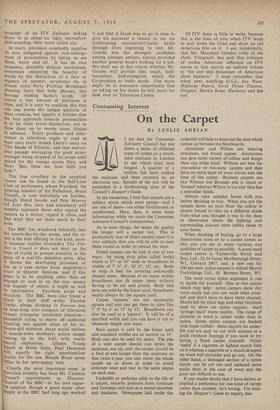Consuming Interest
On the Carpet
By LESLIE ADRIAN In the meantime, I find that carpets are a subject about which most people—and I am one of them—are either ill-informed or uninformed. Here, then, is some basic information while we await the Consumer Advisory Council's comparisons.
As in most things, the better the quality the longer will a carpet last. This is particularly true of fitted carpets since it is very unlikely that you will be able to turn these round in order to spread the wear.
Fitted carpets can be laid in one of two ways: by using strip (also called body) which is 27" or 36" wide or broadloom in widths of 7' 6", 9', 10' 6", 12', etc. Body or strip is best for covering awkwardly shaped areas. Because of its many widths broadloom can fit many areas without having to be cut and joined. Body and strip are sold by the linear yard, broadloom nearly always by the square yard.
Carpet 'squares' are not necessarily square and you can get them in sizes like 7' 6" by 6' or 15' by 12'. Broadloom can also be used as a 'square'. It will be of a specified width and you can have it cut to whatever length you want.
Stair carpet is sold by the linear yard and standard widths are as narrow as 18". Body can also be used for stairs. The pile of a stair carpet should run down the staircase, not up, and the carpet should be a foot or two longer than the staircase so that twice a year you can move the whole carpet up or down in order to avoid constant wear and tear in the same places on each step.
Underfelt or underlay adds to the life of a carpet, absorbs pressure from furniture and footsteps and acts as a sound-absorber and insulator. Newspaper laid under the underfelt will help to keep out the dust which comes up between the floorboards.
Axminster and Wilton are weaving processes, not brand names. Axminsters can give more variety of colour and design than any other kind. Wiltons are best for one-colour or two-tone carpets and they have an extra layer of wool woven into the base of the carpet. Brussels carpets are like Wiltons but Brussels pile is uncut or 'looped' whereas Wilton is cut and thus has a smoother finish.
Always take samples home with you before deciding to buy. When you put the sample down on your floor the colour is almost bound to take on a different shade from what you thought it was in the shop or showroom where the lighting and surrounding colours were unlike those in your home.
When thinking of buying, go to a large department store or to a carpet centre so that you can see as many varieties and qualities of carpet as possible. A good wool carpet centre is Turberville Smith and Son, Ltd., 32-34 Great Marlborough Street, WI, Gerrard 3867, and a new one for 100 per cent. nylon carpets is Alfred Morris Furnishings Ltd., 60 Berners Street, Wl.
The wool versus nylon argument is one to decide for yourself. One or two points which may help: nylon carpets show dirt more easily but you can wash them your- self and don't have to have them cleaned. Marks left by chair legs and other furniture tend to show on nylon carpets; wool 'springs back' more readily. The range of patterns in wool is rather wider than in nylon. Some nylon carpets are backed with foam rubber; these require no under- felt and are easy to cut with scissors or a knife (without fraying) if you want to try laying a fitted carpet yourself. Nylon 'melts' if a cigarette or lighted match falls on it whereas a cigarette or a match dropped on wool will smoulder and go out. On the other hand, a damaged section of a nylon carpet can be cut out and replaced more easily than in the case of wool and the joins are difficult to see.
If any reader thinks that I have shown or implied a preference for one kind of carpet rather than another, he's wrong. I'm wait- ing for Shopper's Guide to report, t00.


























 Previous page
Previous page